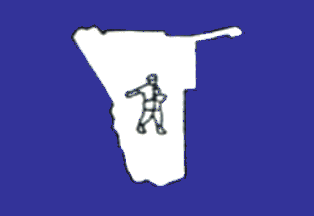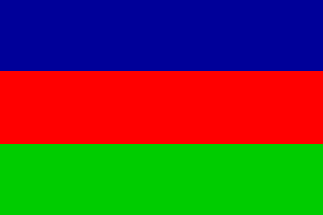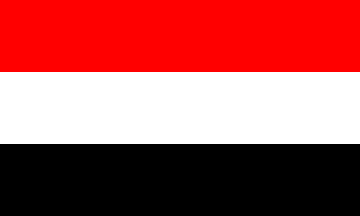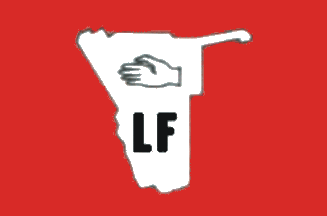 image
by Mason Kaye, 14 June 2004
image
by Mason Kaye, 14 June 2004

Last modified: 2005-10-08 by bruce berry
Keywords: namibia | turnhalle | swapo | swanu | cod |
Links: FOTW homepage |
search |
disclaimer and copyright |
write us |
mirrors
 image
by Jorge Candeias, 12 Dec 1999
image
by Jorge Candeias, 12 Dec 1999
In Dorling Kindersley's 'Flags of the World', it says that the Namibian flag
combines the colours of the SWAPO flag with that of the second largest
party, the DTA.
I know that SWAPO used a blue-red-green horizontal tricolour during
the independence struggle, but what was the DTA flag?
Vincent Morley, 19 Feb 1998
The flag with blue red green horizontal
stripes on the Namibia page is the flag of SWAPO (one of Namibia's main
political parties) as illustrated on p. 20 of the book "Collins Eyewitness
Guides FLAG" written by William Crampton published 1989 and in 1990 by Dorling
Kindersley in the UK [cra90n] and by "Collins" in
Australia where I live.
Gilbert Read, 02 Sept 2005
![[South West Africa National Union (SWANU) flag]](../images/n/na}swanu.gif) image
by Jarig Bakker, 2 Apr 2001
image
by Jarig Bakker, 2 Apr 2001
There was another liberation movement called SWANU, with a similar flag.
Does anyone know about this flag?
Mark Sensen, 10 Aug 1999
I think it was dissolved in the early '80s. According to a Danish encyclopedia,
SWANU was established in 1959 and SWAPO in 1960.
Ole Andersen, 14 Aug 1999
The flag of SWANU (South West Africa National Union) was very similar
to that of SWAPO (South West Africa People's Organisation) in that it also comprised the three horizontal
stripes of blue, red and green. In the case of SWANU, two narrow
gold stripes separated the blue, red and green from one another. The SWANU
flag was thus blue, gold, red, gold and green stripes in the same
construction format as the current flag of Gambia.
Bruce Berry, 18 Aug 1999
SWANU (South West African National Union) at first joined hands with
SWAPO. Later this Hereo-supported group joined with the Damara Council
and other smaller groups to form a multiracial coalition.
Source: Political Handbook of the World, 1997.
SWAPO in Namibia represents the major Ovambo group (47% of the Namibian
population), while SWANU (is that now Congress of Democrats?) represents
the Herero (7%) and
Damara (7%).
Jarig Bakker, 2 Apr 2001
![[Congress of Democrats flag]](../images/n/na}cod.gif) image
by Antonio Martins, 24 May 2000, after image from this
site, reported by Dov Gutterman, 14 Apr 2000
image
by Antonio Martins, 24 May 2000, after image from this
site, reported by Dov Gutterman, 14 Apr 2000
There is a new party, the Congress Of Democrats. Its flag has a blue
field. There are two white lines that form a cross divided in four equals
parts with a big yellow five pointed star in the center fimbriated in white.
The fimbriation joins with the two lines (same width). The flag is printed
in colorful leaflets of the party. They have T-shirts with the flag too.
And in the central of the party in Windhoek, their flag is flying from
a pole painted with blue and yellow stripes; on another higher pole the national
flag is flying.
Santiago Tazón, 25 Oct 1999
![[DTA logo]](../images/n/na})dta.gif) image from this
site, reported by Gary Selikow, 2 Dec 2001
image from this
site, reported by Gary Selikow, 2 Dec 2001
At a simplistic level Dorling Kindersley is probably true. The flag
of the Democratic Turnahalle Alliance (DTA) is equal horizontal stripes
of blue over red, charged in the centre with a white roundel bearing a
hand couped at the wrist, giving the "Victory" sign, in blue outline, above
the letters D.T.A. in red. This was the flag in use at the time of the
1989 elections.
Previously the DTA used a flag which was vertically divided in the
centre, with light blue at the hoist and white in the fly. There were eleven
gold stars forming a circle, one for each of the ethnic groups in the territory.
Bruce Berry, 20 Feb 1998
Turnhalle (literally : Gymnastics Hall in German, ed.) is the name of the sports house in Windhoek where the constitutional conference about Namibia was held in September 1975. The Hall was built in 1913 by the Germans. At the conference there were 134 delegates from 11 organizations present:
On the occasion of the funeral for murdered Herero-chief and president
of the Democratic Turnhalle Alliance, Chief Clemens Kapuno, the tribal
flag was also displayed.
Source: Deutsche Zeitung 16 of 14.4.1978, via O. Neubecker
In documents about DTA, I have seen photos of big meetings of the alliance,
plenty of flags. But not only the usual DTA flag but a version with the
same colors (blue, white and red) but in three horizontal stripes, really
they are Dutch flags. Mixed with usual DTA flags they got the effect.
Santiago Tazón, 25 Oct 1999
The flag of the Democratic Turnhalle Alliance (DTA) of Namibia has the
logo on this
website in the middle : ie the circle with the hand and the lettering
with the colours as described by Bruce Berry. It can be found on the left hand
top corner at this website
Gary Selikow, 2 Dec 2001
 image
by Mason Kaye, 14 June 2004
image
by Mason Kaye, 14 June 2004
From the of maps on flags provided by Mason Kaye, we have a blue map of
Namibia on a white background.
Rob Raeside, 14 June 2004
The blue flag (blue as in image, not black as in description) is the flag of Baster Party (Rehoboth Liberated
Democratic Party).
Jaume Ollé, 14 June 2004
 image by
Anto'nio Martins-Tuva'lkin, 14 June 2004
image by
Anto'nio Martins-Tuva'lkin, 14 June 2004
This is quite different from the traditional Rehoboth flags previously referred
to as being:
" In 1872 a national flag of German influence was adopted: it was black over white over red. Another, more distinctive variant comprised concentric squares of, from the inside, white, red,
black".
However, we have only the 'variant' depicted. Above is the 1872 Rehoboth flag,
with assumed ratio 3:5.
Anto'nio Martins-Tuva'lkin, 14 June 2004
 image
by Mason Kaye, 14 June 2004
image
by Mason Kaye, 14 June 2004
The red flag is the flag of the Labour Front (represents merged people).
Jaume Ollé, 14 June 2004